After my time with the Ruger PC Charger I’ve become quite fond of the SB Tactical FS1913 folding brace. It comes in two configurations, a polymer model and an aluminum one and there are differences worth noting.
The FS1913 brace attaches to M1913 Picatinny rails. Big surprise, right? This brace was initially designed for use on SIG MPX and MCX pistols, but the M1913 rail as a brace attachment point on pistols (and as a stock attachment point for rifles) has moved well beyond the SIG weapons.
The FS1913 and FS1913A
Braces are probably my top pick for firearm accessory of the century and their continued evolution has been fantastic to watch. The FS1913 brace is about the most minimalist brace out there that’s still useful.
The official nomenclature is FS1913 for the polymer strut model and FS1913A for the aluminum strut model. The aluminum brace weighs 13 ounces and the polymer model is three ounces lighter. The aluminum version is 9.25 inches long and the polymer brace is 9.6 inches.
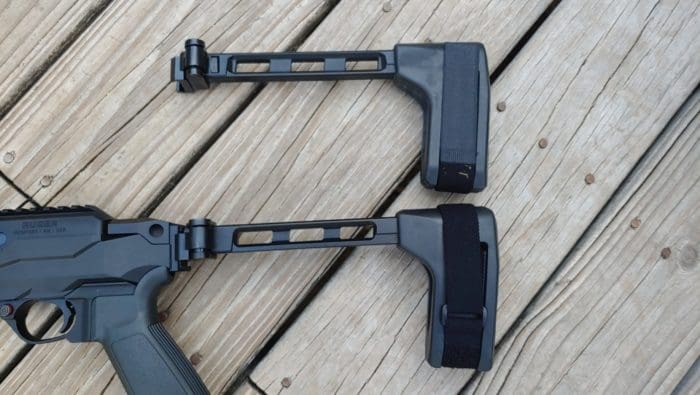
Both braces are robust and well made. The polymer model is less expensive with an MSRP of $199. The aluminum models have an MSRP of $249. Both feature an identical, rubberized arm brace and stretchy, hook and loop-covered strap for attachment to your forearm. Besides the slight weight and length differences, the two braces felt nearly identical when used.
Tossed In and On
Both FS1913 braces have a metal attachment point that mounts perfectly on a length of 1913 rail. They are robust and attach with ease. Make sure you tighten it down well.
These are side-folding braces so recognize that our glorious overlords at the ATF have declared that any OAL measurement requires the brace to be in its smallest position when doing the measuring. This is important if you’re building your own.
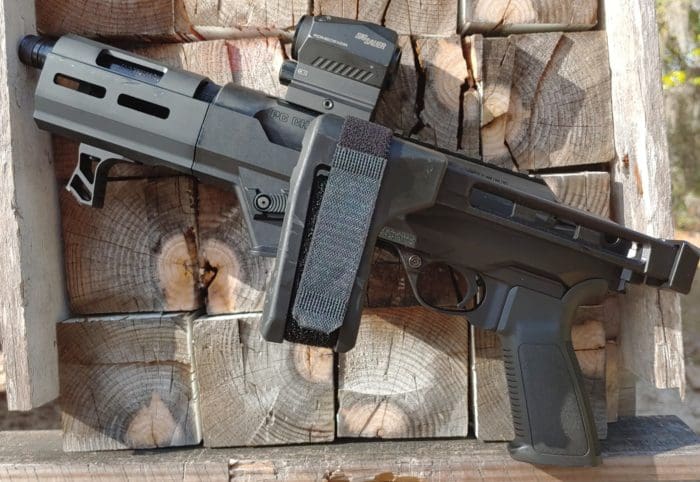
The FS1913 brace folds to the left (it can be folded right by removing the hinge and re-installing it upside down) and holds itself folded via a pull-through detent. Meaning, to extend it you simply pull the rubber arm brace part away from the firearm to overcome the detent’s hold.
When deployed, a “tooth” on the brace-side half of the hinge falls into a notch on the gun-side half. They’re held together under spring pressure and lock relatively securely.
To unlock, pull up on the strut to lift that “tooth” out of the notch. It helps to place a thumb on the firearm in front of the hinge and then lift up on the FS1913’s strut with your other fingers. It’s a fast, intuitive, and rather smooth process. The hinge mechanism is made from steel for a long lifespan.
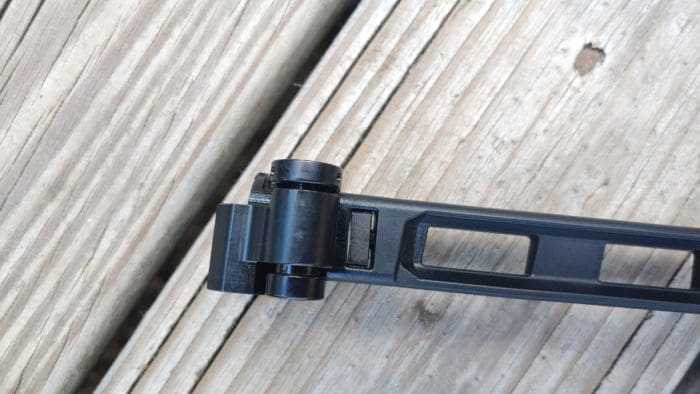
To The Range
Currently, my only M1913 Picatinny rail-compatible firearm is the Ruger PC Charger, but I do own a Cobray M11/9 and 1913 adapters exist for it. [ED: scroll to the very bottom for photos of the FS1913 on lots of other firearms). On the PC Charger, the brace was almost perfect. The only downside involved the brace not locking folded when the PC Charger’s reversible charging handle was on the left side of the gun. With AR-type charging handles, or right-handed charging handles this won’t be an issue.

Keep in mind my sample size of one 9mm subgun isn’t a big one, but I ran into one issue with the FS1913 polymer model. When testing some of the SIG SAUER 124-grain +P M17 ammunition through the PC Charger the brace unlocked itself three times in 50 rounds. [ED: SB Tactical’s first run of hinges had a geometry issue that made them unlock too easily. This was quickly resolved and the FS1913 will no longer unlock under recoil unless the user applies excessive upwards pressure on it.]
It didn’t unlock with further M17 ammo, or with any other 9mm load. The FS1913A never unlocked [ED: all FS1913As employ the newer hinge design]. Again, these braces are designed for guns like the MPX that use a gas piston operation which results in less recoil than a blowback system so that could be the reason. There is always the possibility that I goofed up somewhere along the way.
Other than those two instances there were no other issues or differences between the two FS1913 models. If you try hard enough you’ll notice the weight difference, but the slightly longer length of the polymer FS1913 brace is a bit more noticeable. I have long arms and the little bit of extra length is nice.
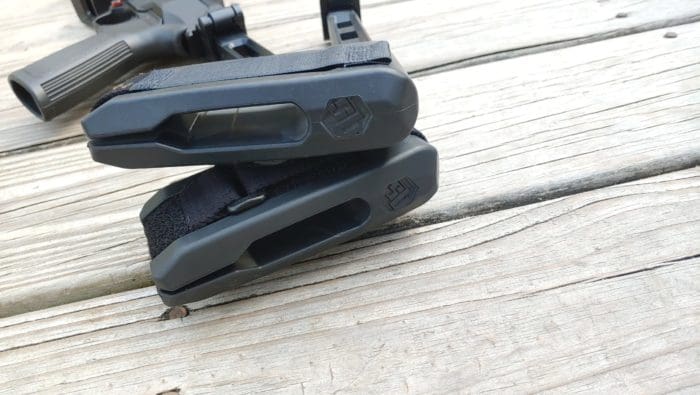
The brace portion of both models is rather small for my above-average sized forearms. It was a little tricky to slip them over my forearm and latch down without something to set the gun down on. This micro-sized brace is trickier than the original SB15 brace and a range table helps quite a bit in getting the brace mounted on your forearm.
I found the strap to be incredibly comfortable. It’s soft and stretchy enough to prevent it from digging into your forearm. It adds a good degree of stability and makes using a red dot on such oversized pistols possible and more practical.
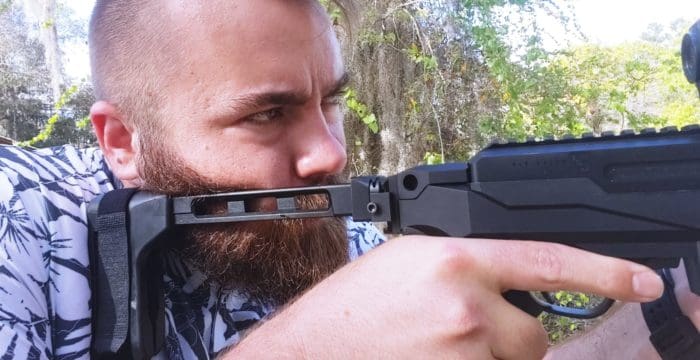
If you choose to use the brace as a cheek weld, you’ll find that it really is not a shoulder stock. It doesn’t provide as much structure on which to rest your cheek. You get some, but it’s relatively skinny.
If you want to misuse your SB Tactical brace and shoulder it (gasp!) as you’re legally allowed, you may find it a little narrower than an actual shoulder stock typically is. In fact, if you’ve used the much wider SBA3 a lot you’ll notice the difference.
That being said, the FS1913 is still very supportive and comfortable when shouldered and allows you to handle a pistol with much greater ease. Especially when it comes to light recoiling weapons like the PC Charger.
Specifications: SB Tactical FS1913 and FS1913A Pistol Stabilizing Braces
Length: 9.6 inches (polymer) 9.25 inches (aluminum)
Width: 1.2 inches
Strap Width: 1 inch
Weight: 10 ounces (polymer) 13 ounces (aluminium)
MSRP: FS1913 $199.99, FS1913A $249.99
Ratings (out of five stars):
Ergonomics * * * *
This is an excellent tool. The length is good and the strap is comfortable, but it’s a little tough to get on without the use of a table. If you shoulder it you’ll find a cheek weld is skinnier than what you’d expect from a shoulder stock, but it’s still supportive, solid, and comfortable.
Reliability * * * (FS1913) * * * * * (FS1913A)
The polymer model collapsed three times in several hundred rounds of testing with the PC Charger when using +P ammunition. I continued to use the same +P ammo and ran into no other issues. The aluminum model has never collapsed while firing with the same gun and the same ammo. [ED: this issue in the original hinge design was resolved by SB Tactical within a few months of the FS1913’s initial release, and unlocking while firing doesn’t occur on newer units]
Overall * * * *
The FS1913 and FS1913A folding braces are a low profile option for those with rear M1913 Picatinny rail-equipped pistols. It folds, it’s lightweight, and it’s stable every way you use it.
.
Jeremy S. Edit:
I’ve been shooting with the FS1913 and FS1913A extensively over the last year with calibers including .22 LR, 5.56, 300 BLK, 6.5 Creedmoor, .308, .458 SOCOM, 375 Raptor, and more. For the most part this has been on Black Collar Arms Pork Sword Pistols, where we find the FS1913s to be the best pistol braces available for these compact, bolt-action pistol builds. We love their light weight, how incredibly compact they become when folded, and their nice cheek weld.
Here are some photos of different guns I’ve had an FS1913 or FS1913A on over the last few months (and took a photo of):
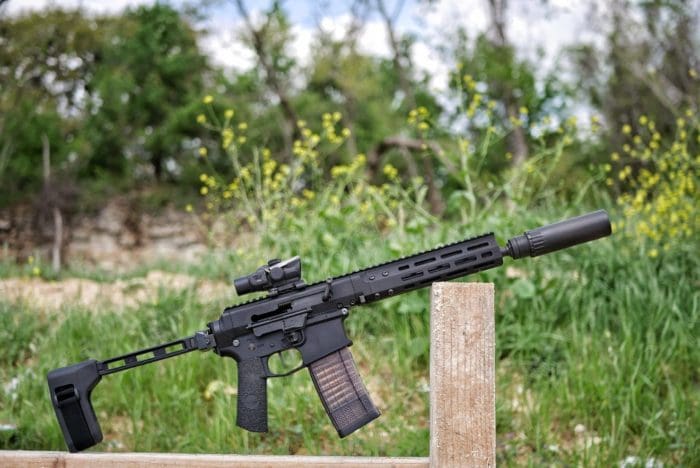
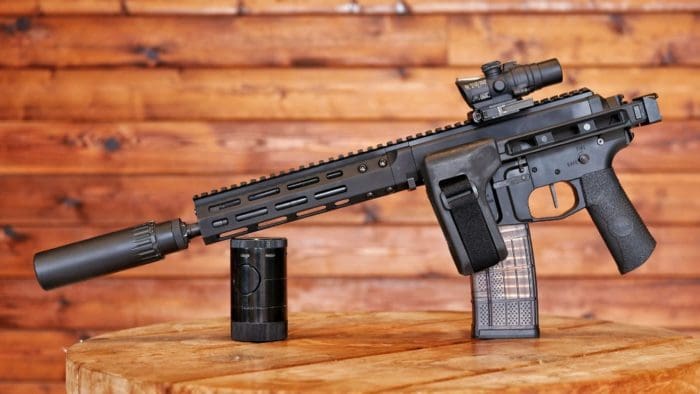


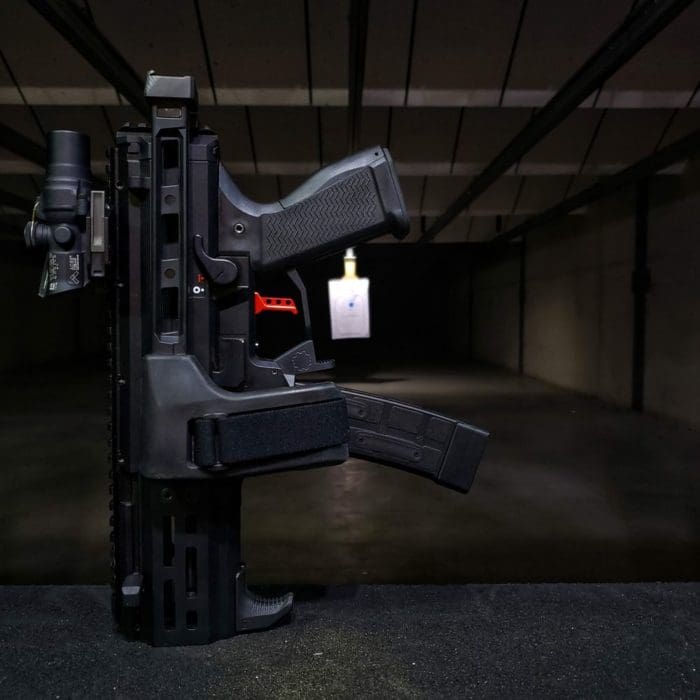
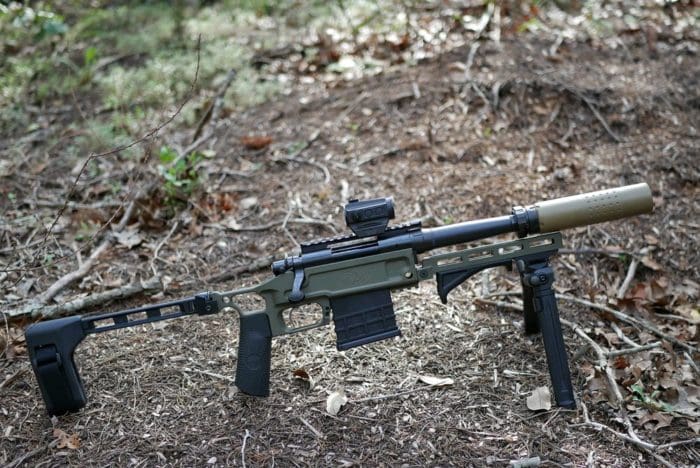
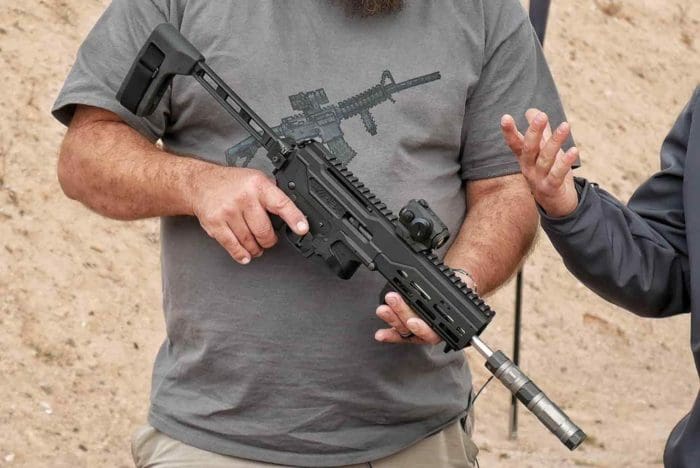
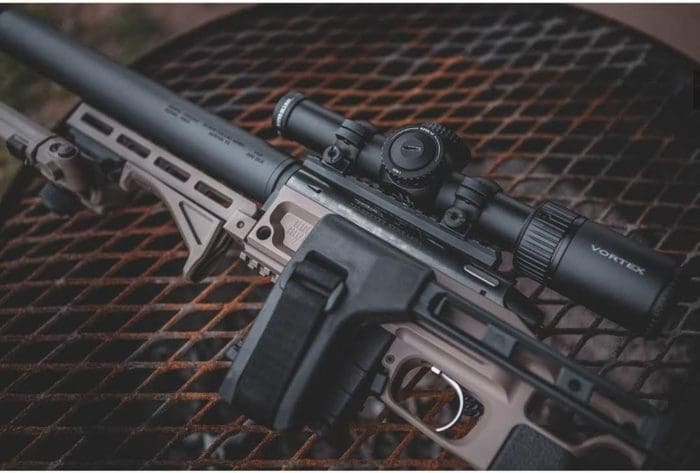
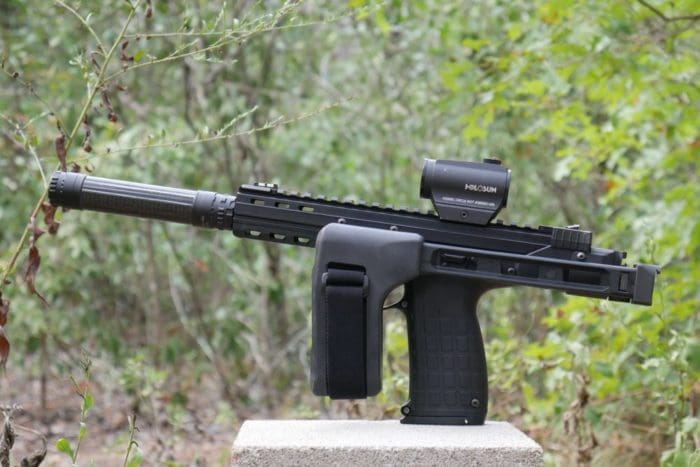

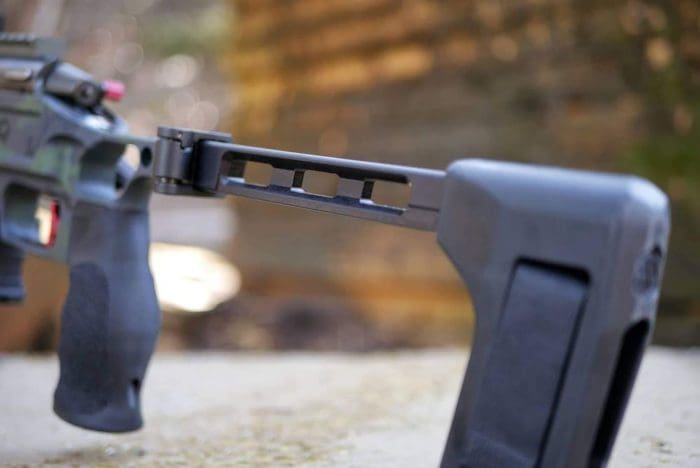
One of the great things about the FS1913A (seen immediately above and below) is that it can be Cerakoted:
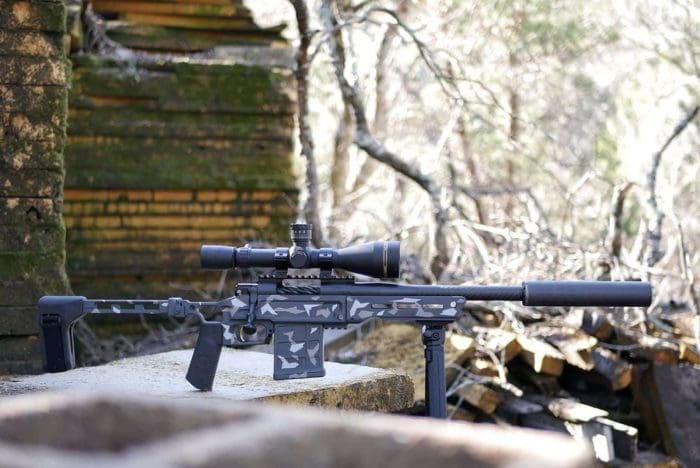






I originally had the FS1913 on my MCX pistol. I also had issues with it unlocking while firing. I contacted SB Tactical and they offered to either send me a new attachment block to install myself or ship me a new one free and they would provide a return shipping label.
I inquired if I could upgrade to the FS1913A aluminum brace if I payed the difference in price and they offered to send my the FS1913A free of charge. Great customer service all around, I have not had any unlocking issues and the FS1913A feels a lot sturdier.
The Ruger Charger has been on my list for a while. The $50 cheaper for the polymer seems to be the better deal for a .22lr.
Thanks for the review.
For the money, SB should have made the aluminium one out of 7075, and not 6061.
I’ve got a fs1913 on my brn180 pistol build it works great but also won’t lock folded because of the rubber bumper on the brn180s upper. I’ve thought about shaving it down but haven’t decided if I want to shave the bumper or the brace.
You could just remove the bumper. The rubber of the brace won’t mar the finish on the BRN.
SBA3s and SBA4s can also be cerakoted without issue. Just need to tape off the rubber portion as I’ve done several times. Not sure why the author points that out as a unique feature for the 1913.
I point that out as a unique feature of the FS1913A as compared to the FS1913. The polymer strut of the 1913 isn’t a good Cerakote candidate at all, whereas the aluminum strut on the brand new 1913A is good to go. I did not mean to imply that the FS1913A is the only thing on the planet that can be Cerakoted 😉
Jeremy
Nice article thanks. What is the firearm in photo #7? Even zooming in I can’t make out a name or identifying mark.
Thanks,
Mr. Wilson.
Yeah, I’d like to know as well. Thanks!
Can’t find a FS1913A to purchase. Did SB Tactical discontinue making these?
I ordered mine a week ago and was notified shipping in Oct
Cannot get FS 1913 to release to fold, fear giving too much force, possible of breaking handle. Any advice to getting it to release would be appreciated.
I give mine a sharp smack right underneath the hinge with the heel of my hand then put my thumb on top of the hinge and pull up with the fingers of the same hand.
This is really interesting, You’re a very skilled blogger. I have joined your feed and look forward to seeking more of your great post. Also, I’ve shared your site in my social networks!
I have the FB1913 and had trouble both with folding and unfolding the brace. Once I figured out how to fold the brace by doing what this article suggested, along with the instructions that came with the brace, I had trouble unfolding it…it simply came off of the pic rail a number of times. I ended up pulling the metal hinge up allowing it to release. Just pulling the rubber portion of the end of the brace failed to work for me. I use this on a Kel Tec PLR16. Hope this might help someone out there who is having issues.